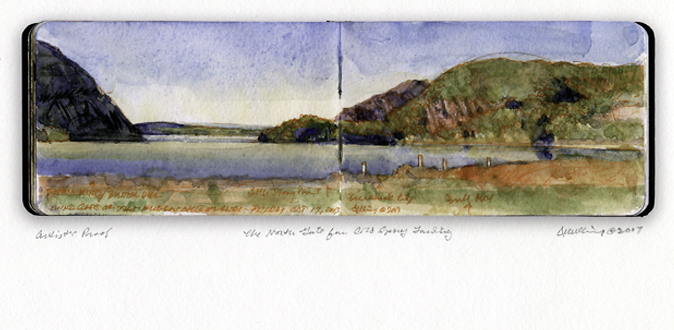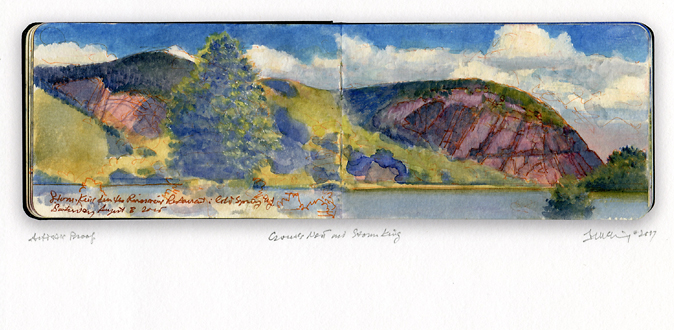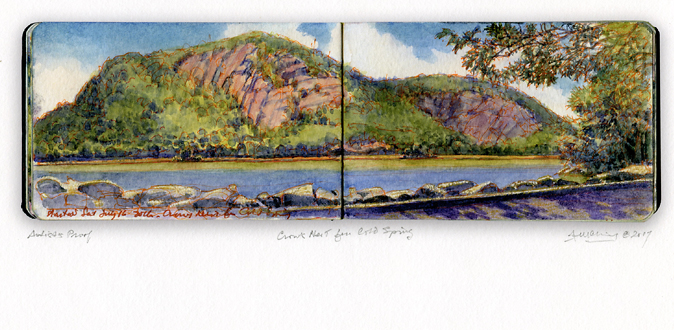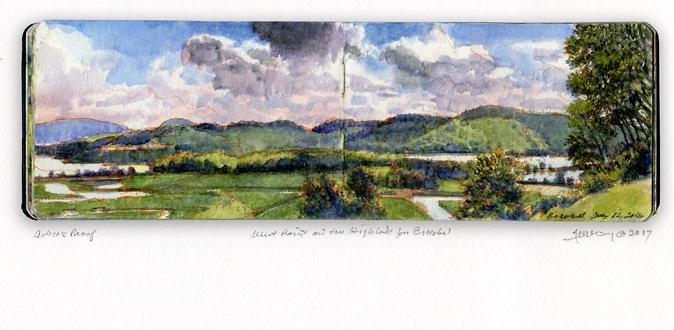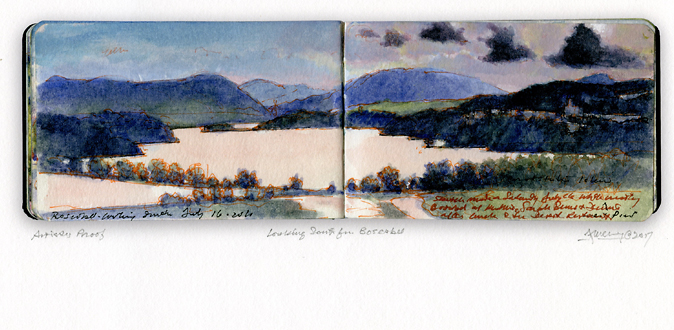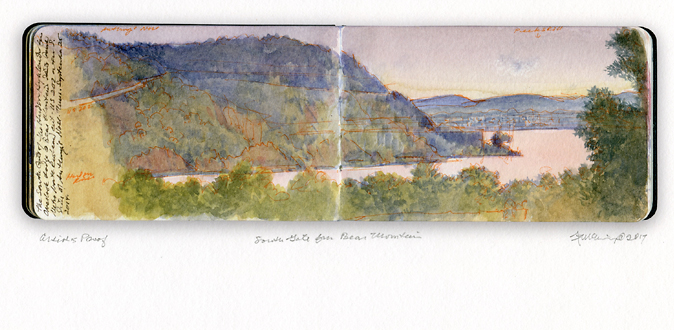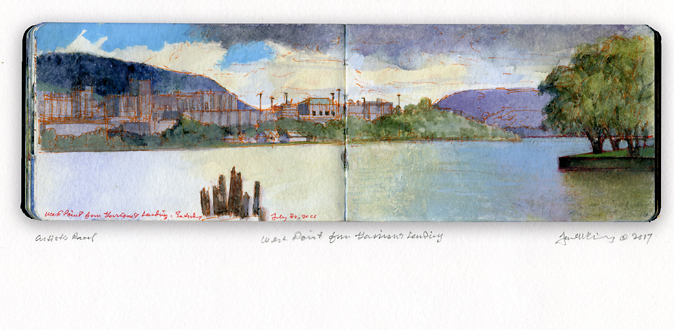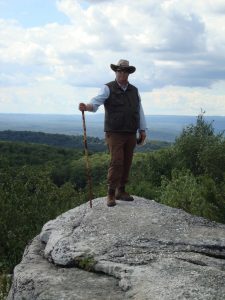
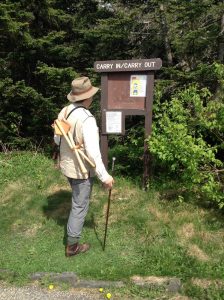
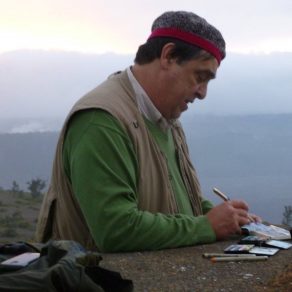
Images (left to right: In the Hudson Highlands, Atop Mount Greylock, Dawn: Kilauea Summit)
For the past ten years the majority of my new paintings have migrated into books. The change occurred gradually, not as any kind of plan. No theoretical epiphany preceded the shift. The idea just caught up with me. As a bibliophile fond of travel, I succumbed to my fate without protest. It was liberating. Personal mobility actually expanded my artistic practice. Whatever materials I might need could be carried in my pockets, travel-vest or shoulder-bag.
Someone asked me, “Where is your studio”
“You’re looking at it” I replied
Having completed hundreds of page-spreads, the question that arose was how to exhibit them. The traditional solution would be to lay them out in vitrines, open to single page-spreads. Another method was to transform painting-journals into animations, such as those that greet visitors to this website’s homepage. Neither mode of presentation could simulate the experience of perusing one of these books manually. Given their nature, it would be complicated logistically, exposing the objects to potential damage. If I were to exhibit these works in the conventional way, I had to be open to selling the books without cutting them up to accommodate some form of wall-display. Receiving a list of book-binders from the Center for Book Arts in New York City I found a few who could build me an octavo-sized solander (clamshell) box in which the original painted books could be housed. Following every conversation I came away with a case of sticker-shock. Many of these skilled craftspersons had a backlog of several weeks. I decided to do more research.
In August of 2016 my wife presented a paper at a symposium at Tate Britain. After visiting several paper-shops and binderies in London I brought one of these books to Wyvern Bindery on Clerkenwell Road. Stepping through the storefront door transported me to a Dickensian workshop filled with rolls of fabric, glue-pots, bustling workers and front-man Mark standing behind a wooden counter. I described my predicament. At the end of the following day he presented me with the solution, at a lower cost than would have been possible in New York. Manhattanites presume that everything on the planet is for them just a cab ride away. Not so. During the past two years, we have witnessed the extinction of the last privately-owned full-service art-supply stores in New York. Many bookstores have suffered similar fates. My impression is that London retains a culture of artisanal binderies, and a deeper commitment to books as works of art–not just delivery devices for texts and images. There are exceptions of course–the museum shops and venues like Strand, Printed Matter, McNally-Jackson, relocated Rizzoli and others. Books seem to be gaining visibility in museum exhibitions. Vitrines displaying sketchbooks and ephemera were seldom seen twenty years ago, but now are de rigeur.
One question remained unanswered. As I continue to paint in books, how might I recreate for purposes of exhibition the experience of having a book in hand, open to a painted page-spread? I brought one of these books to a number of prominent New York art-dealers, who generously shared their suggestions.
With a wink, Dick Solomon wondered aloud what kind of lunatic would ever think that painting in books had any commercial value. The question he said, was “how to get the genie out of the bottle.” He suggested that I consider turning them into prints. A month later I found myself in Berlin, spending the better part of a day in the back room at Walther Koenig Buchhandlung, at 27 Burgstrasse, next to the Museum Island. While most of the books were by contemporary artists, historical precedents became obvious. Not only did I envision a dialogue with Claude Lorrain and Piranesi, but also with Hogarth and Turner. Producing a suite of prints would create a dialogue between my work, and William Guy Wall’s Twenty-four Hudson River Portfolio. Combined with Benson J. Lossing’s The Hudson from the Wilderness to the Sea my project could look to precedents in the history of American art and with expeditionary artists who described places that tourists would later visit. Thus were pictures of the land inscribed upon our collective identity.
Several challenges arose. The first was finding a printer who could transform my page-spread diptychs into archival digital prints. My visit to Walther Koenig had reinforced an esthetic decision to “break” the books into single sheets, while leaving the book itself intact. This returned me to the idea of setting the prints into some kind of portfolio, or loose binding. During a visit to Amsterdam I had taken in the Hercules Seghers exhibit, which later came to the Metropolitan Museum of Art. The bookstore at the Rijksmuseum had commissioned a suite of reproductions of seven Seghers etchings, housed in a rigid portfolio with side-ties. The companion booklet (chapbook) was the same size as the prints. I found it unwieldy, but the idea of seven prints resonated with me. Dick Solomon has recommended six, but I liked the idea of a baker’s half-dozen.
While I was at Yale in the mid-1970s, I had acquired a suite of reproductions of Henri de Toulouse-Lautrec’s circus drawings, with text by William Seitz, published by Harry Abrams in 1967. Like the Seghers, the prints were held in place by a series of paper flaps, inside two boards hinged at the spine. The Lautrec suite did not have the vexation of grosgrain ties. Too me it did not feel enough like a book. And so I settled on the idea of a cloth-covered Solander (clamshell) box, like the one that had been built for me at Wyvern Bindery in Clerkenwell. Likewise I settled on a chapbook that would be closer to the size of a 19th-century chapbook; octavo, landscape.
The prints were developed with help from the production team at Brilliant Graphics in Exton, Pennsylvania, to recreate the feeling of a whole book, open to a single page-spread. Some aspects of each painting is easier to read in this secondary iteration, than in its original book-form. For this reason, it was important that the prints not be seen as reproductions, but as enhancements of the originals.
I had settled on Brilliant on the recommendation of friends, and positive experiences I had in my interactions with them. The fine work they do for galleries and museums in producing books and catalogues tipped the balance for me, and we went to work.
One hurdle remained, which was how I would be able to pay the printer.
My first solution was to work through a fiscal sponsorship with an organization I shall refrain from naming. After shepherding my proposal through all the proper channels, others who had not been privy to the conversation about this project created a misunderstanding that proved mortal to this particular partnership. Following weeks of conversations back and forth between accountants and others, failing to make any progress, I walked away and shifted direction.
Follow a subscription model, sufficient funds were raised to pay the printer. In mid-August a sudden windfall in the form of a Pollock-Krasner Foundation artist-grant gave me the flexibility needed to move forward. Without it I might have been forced to cut corners, or to sacrifice key elements of the publication. News of the grant stunned me. It also motivated me to work harder, to be worthy of such recognition.
This week (September 5) I placed the order for the boxes and committed to a production schedule. The Hudson Highlands suite will be published officially on November 1, 2107. There will be launch events and other festivities, to be announced very soon. All will be posted both here, and on social media.
Below is a preview of the limited edition, with two PDFs; a prospectus, and a sample copy of the chapbook. Comments are welcome. Please share this link with others who might like to know about Hudson Highlands.
Look inside the chapbook:
For more information on the Hudson Highlands Suite, please see the PDF below:
To order:
